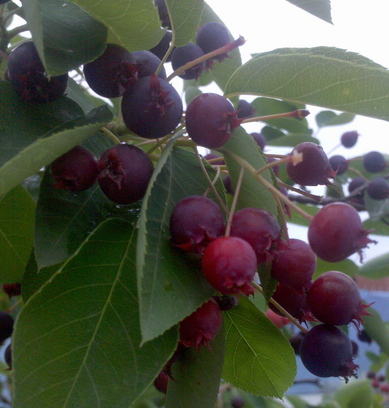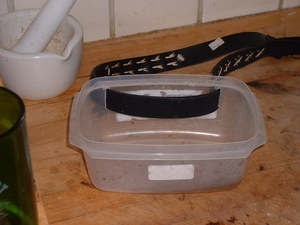Ideas for enjoying the bounty of wild berries ripening right now in the Ann Arbor area

Ripening fruit of the Service Berry Tree (Amelanchier) photographed in downtown Ann Arbor. This tree was removed to make way for the underground parking garage on Fifth Ave.
Linda Diane Feldt | Contributor
The simplest method of finding a tree heavy with fruit is to look down. The sidewalks will be stained, the ground will have fruit attracting flies and other insects. My dog will pause to find dropped fruit still edible, and she won’t want to move on for some time.
You can also look up. Branches are heavier with ripe fruit, and the green leaves can’t hide the luscious multicolored fruit as it ripens.
This last weekend, the mulberries and the serviceberries suddenly ripened — which they do every year, but it still usually catches me by surprise. I watch the unripe fruit begin to form, and it seems like magic when it is so quickly ripe enough to enjoy.
Many years I never see the ripe berries on my serviceberry tree; the birds descend and strip it clean in a day. Other years the blue berries wait and I can harvest all I want to eat now and freeze for later.
Both the mulberry and serviceberry trees seem to be scattered all over Ann Arbor. I find them on walks through neighborhoods, but there are also many serviceberry trees right downtown.
When I’m conspicuously picking and eating them, I’ve had a number of exchanges with people walking by and asking what I am doing. I find it interesting to note who will eagerly join me in eating the berries and who will back away slowly without being willing to experiment.
I haven’t formed a clear profile of those willing to start foraging when a stranger invites them, but generally they are friendly, open, curious and enthusiastic. They also often share memories of being a kid who spent time outdoors on their own exploring.
For both serviceberry and mulberry, if the fruit is ripe, it is safe to eat. I never harvest near railroad tracks or under high power lines. Both are often sprayed. Under-ripe fruit is generally not considered safe to eat.
Mulberries are very soft when ripe, which is why you should expect to come away with purple stained fingers. There are a couple different varieties of mulberry trees, and most of them have berries that are purple near black. There is a white variety as well; be sure you don’t confuse the white unripe berries from the one tree with the soft ripe berries of the other. A hard mulberry is an unripe mulberry.
What can you do with all this fruit?
Many people eat their fill on the spot. That’s certainly the most popular option.
I do a lot of freezing. Every day I try and pick at least a couple pints, throw them into freezer bags and label them with the date and place.
They’re good for a year, although I will confess to finding stray bags two or even three years old in the corners of my freezer and still enjoying the berries. I like knowing where I picked them. In the winter it reminds me of hot often mosquito infested places —so stunningly different than a cold winter morning.
Pies are tricky. I tend to make crisps instead. With no worries about a soggy crust, the crisp topping is a great combination with the soft berries, made almost soupy by cooking. I combine oatmeal with chopped nuts (walnut and almond are favorites), some cinnamon and maybe some nutmeg.
The berries are used as is, or for a more solid experience I might stir in a tablespoon of arrowroot flour for each 2-3 cups of berries. It helps to thicken them. I add a pinch of salt to the berries as well. I use a layer of 1-2 inches of berries, covered evenly with the oatmeal topping.
Sometimes I melt butter and honey together (about equal parts) and drizzle it on, or just drizzle honey or maple syrup followed by slice thin pats of butter spread along the top. Bake 350 degrees for about 20-30 minutes until slightly browned.
One year my foraging friend and I collected enough cattail pollen to bake with and added that as a fine coating at the end. It was beautiful and an exotic special saffrony taste, like non sweet sugar. Hard to describe, but certainly worth repeating. The cattail pollen has just started. It's tricky to collect, but well worth it.

A plastic container with an old belt threaded through two slits makes a great hands-free container to make picking faster and easier.
Linda Diane Feldt | Contributor
My foraging friend makes fruit leather. I haven’t tried to do that yet, but the process includes sieving the fruit to remove seeds, cooking it with a sweetener (some omit this step), adding lemon juice and drying. There are plenty of recipes online.
Jams and jellies are obvious. I don’t use a lot of preserves, and people give me so many that I always have a couple years supply on hand. So I haven’t made my own in decades.
I’ve experimented with a variety of pies using mulberries frozen with yogurt. That’s a nice desert on a hot summer night. This blog contains one of the mulberry pie recipes I developed.
Serviceberries can be used any way you’d use blueberries. One of my favorite recipes is blueberry cornbread.
There are three “secrets” to my fabulous cornbread. The first is that I grind the cornmeal fresh. Nothing else compares. But if you don’t have access to a flourmill, use the freshest stone-ground corn you can find.
The other is to use a well-seasoned cast iron skillet to cook it. The texture turns out great.
The last is using yogurt in place of buttermilk or milk. It sets up the right chemistry, using both baking powder and soda.
Preheat oven to 400.Oil a 10 inch cast iron skillet, bottom and sides.
Combine 1 cup fresh ground cornmeal,1 cup fresh ground whole wheat flour or buckwheat flour. Commercial flour can be used if necessary.
Mix in 2 teaspoons baking powder, ½ teaspoon baking soda, ½ teaspoon salt.
In a small bowl combine 1 cup plain yogurt, 1 egg, ¼ cup or less honey. Mix well.
Add about 1 cup blueberries or service berries or other small berry (black raspberries are marvelous) to the dry ingredients. Mix well.
Add the wet ingredients, quickly mix until just uniform. It will be a somewhat thick batter.
Transfer the batter to the oiled skillet, and immediately place in the oven to cook.Check it at about 20 minutes. The top should be brown and a knife or toothpick inserted will come out clean. Sometimes it needs more time depending on the moisture in the ingredients.
I also enjoy smoothies with either fresh or frozen fruit. I keep frozen bananas to add for better texture and often add nuts so that my “smoothies” are actually not.
An approximate recipe (I change it all the time) is 1 ½ cups plain yogurt, a handful of almonds walnuts or pecans, about 1 cup or more fruit — combining ½ frozen banana, and whatever berries I have on hand frozen or fresh. I add ice if the fruit is mostly fresh. I sweeten it with 1 tablespoon or less of honey, maple syrup or agave syrup. I use a hand held immersion blender and blend until uniform.
Whether you gather a few berries to eat out of hand, or gallons to last you until next year, this is the time to start. I hope you enjoy the bounty!
Linda Diane Feldt is a local Holistic Health Practitioner, writer and teacher. You can follow her on twitter, visit her website, or contact her directly ldfeldt (at)holisticwisdom.org. Thursday June 23 Linda Diane is giving a free class on introducing kids to foraging. For more information contact The People’s Food Co-op. For more recipes using wild and conventional greens, her cookbook “Spinach and Beyond: Loving Life and Dark Green Leafy Vegetables” is available locally at Morgan and York, Crazy Wisdom, Nicola’s and through Amazon.com.


Comments
Linda Diane Feldt
Thu, Jun 23, 2011 : 12:46 a.m.
My foraging friend, who is now in the vineyards of CA on the first leg of his worldwide bicycle trip, reminds me that these berries also make excellent wine. True, a single taste of his black raspberry wine made me want to start drinking again. Divine. He especially recommends the service berries for that purpose, that is if black raspberries are not available.